



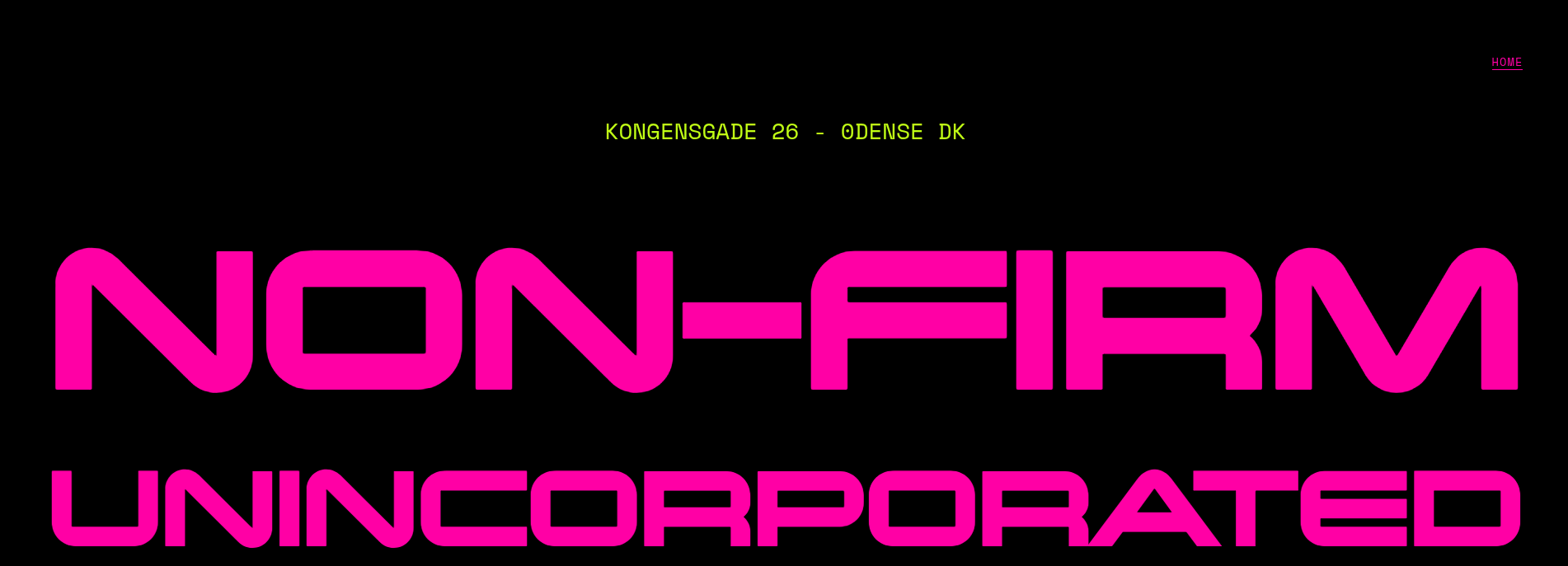
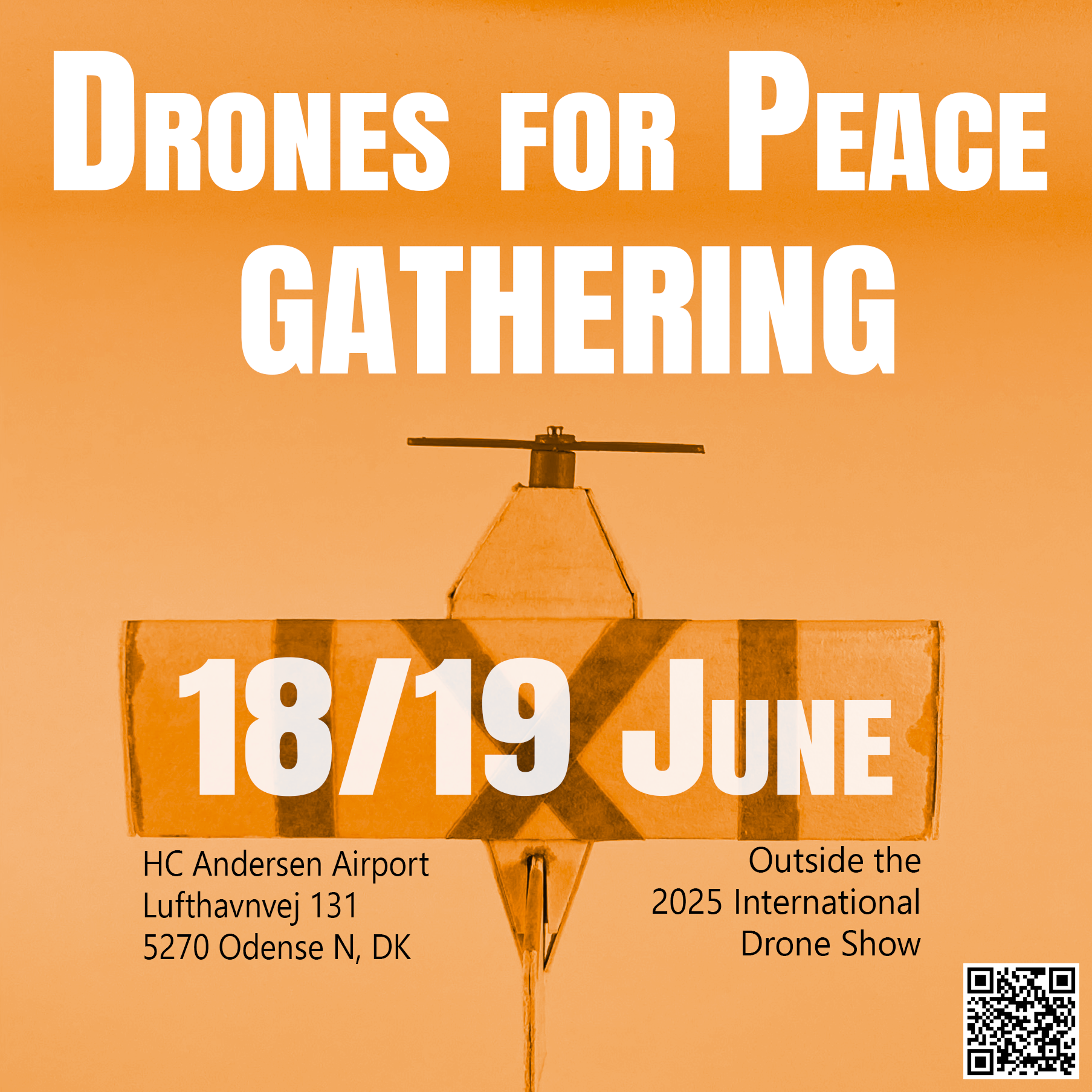
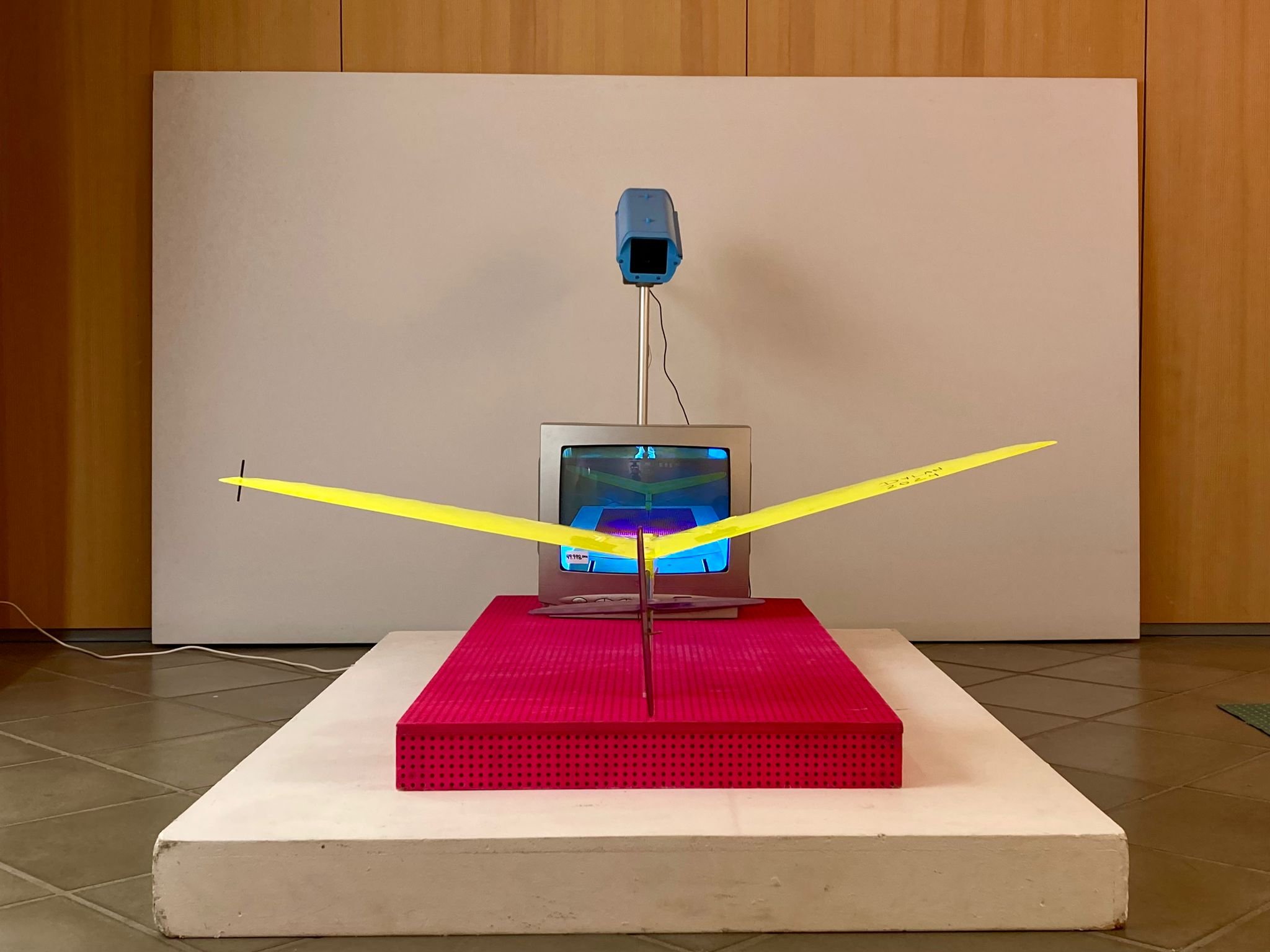
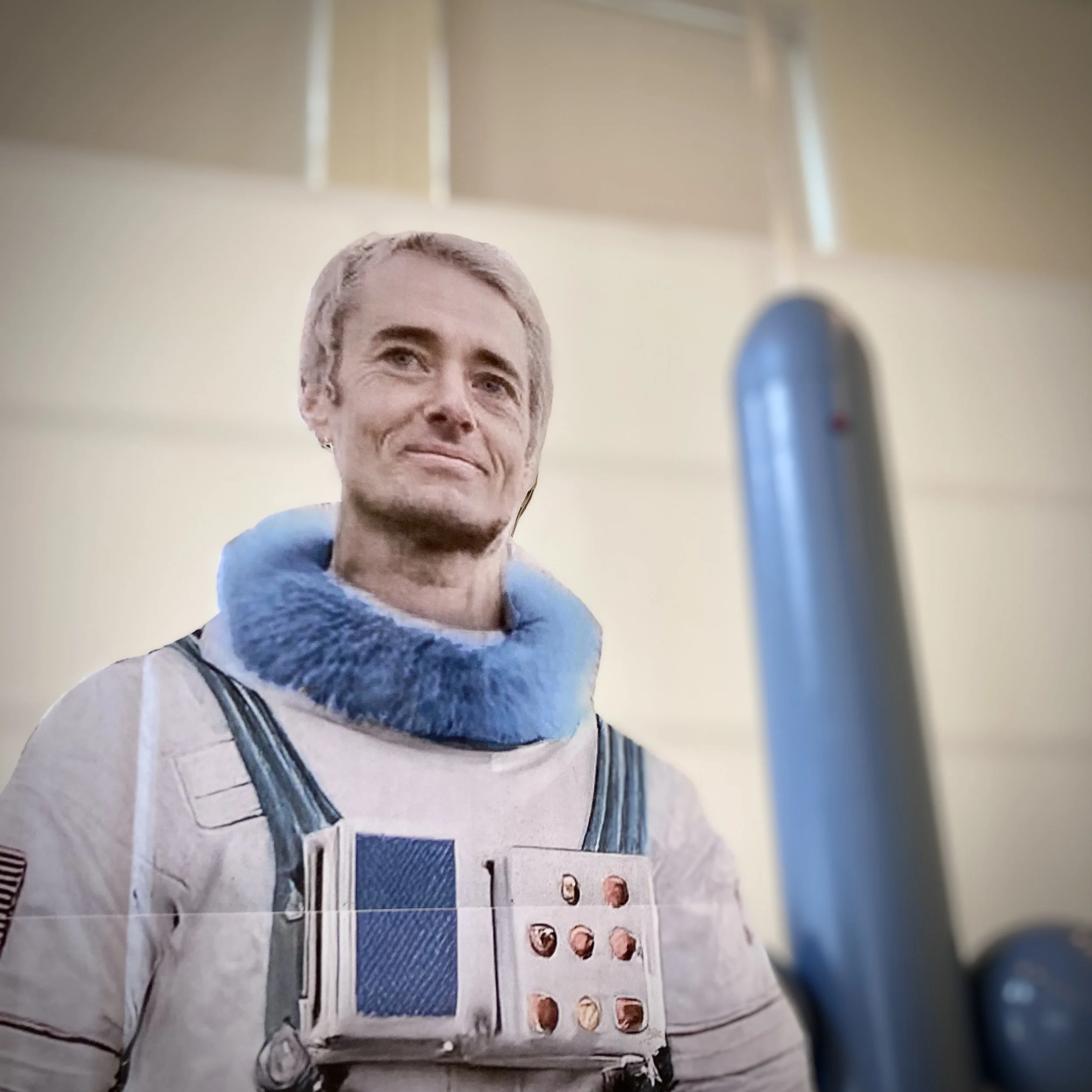



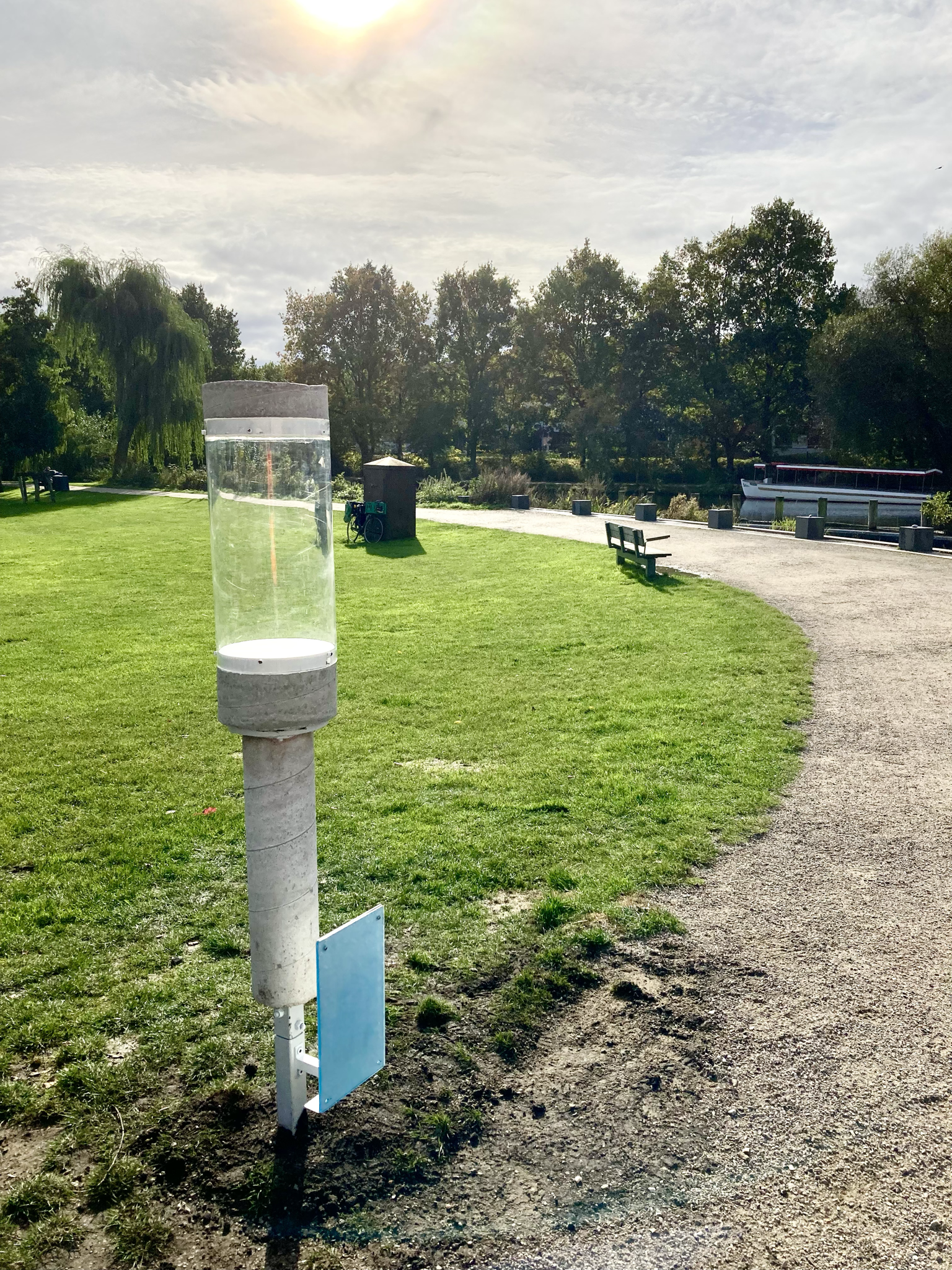

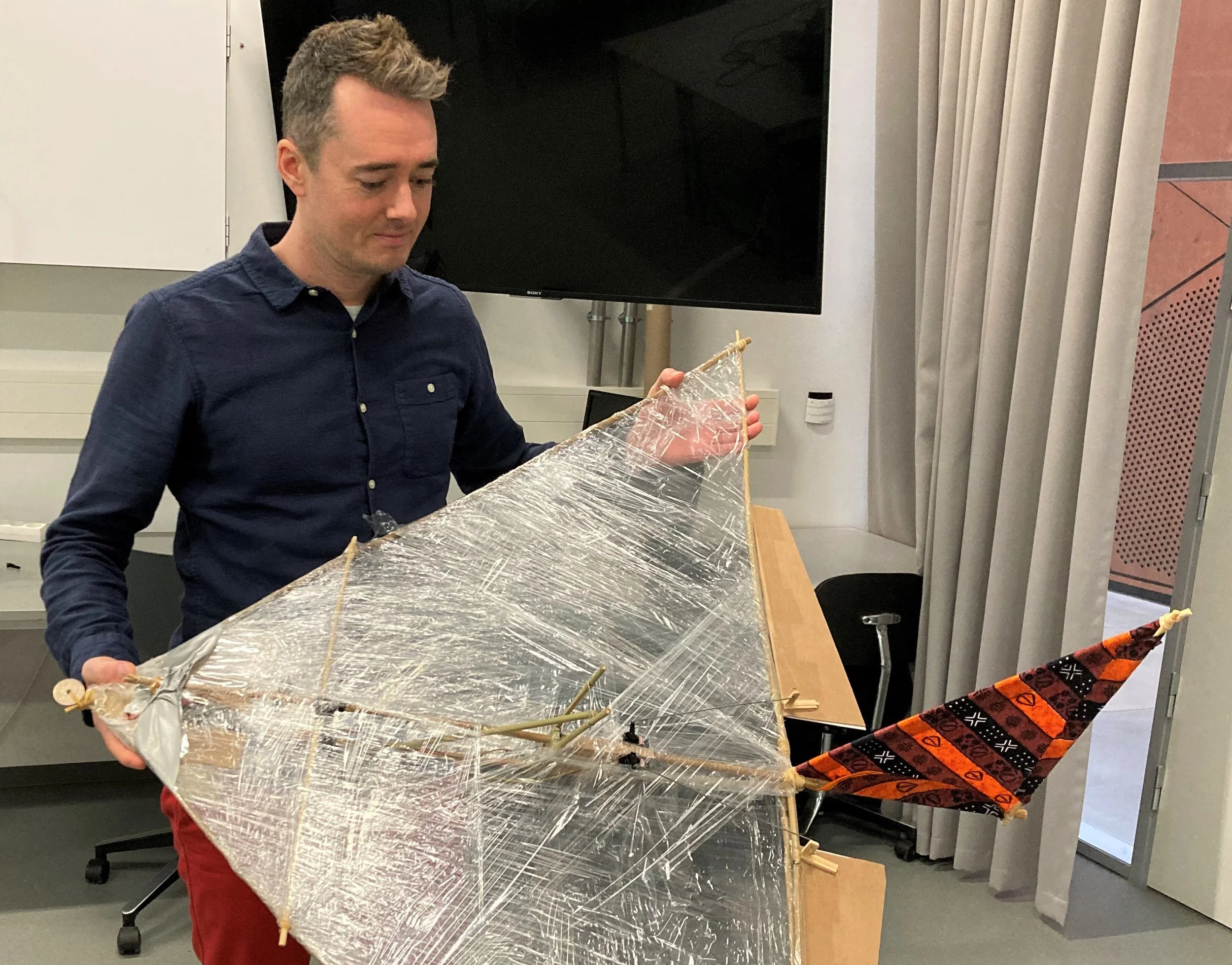









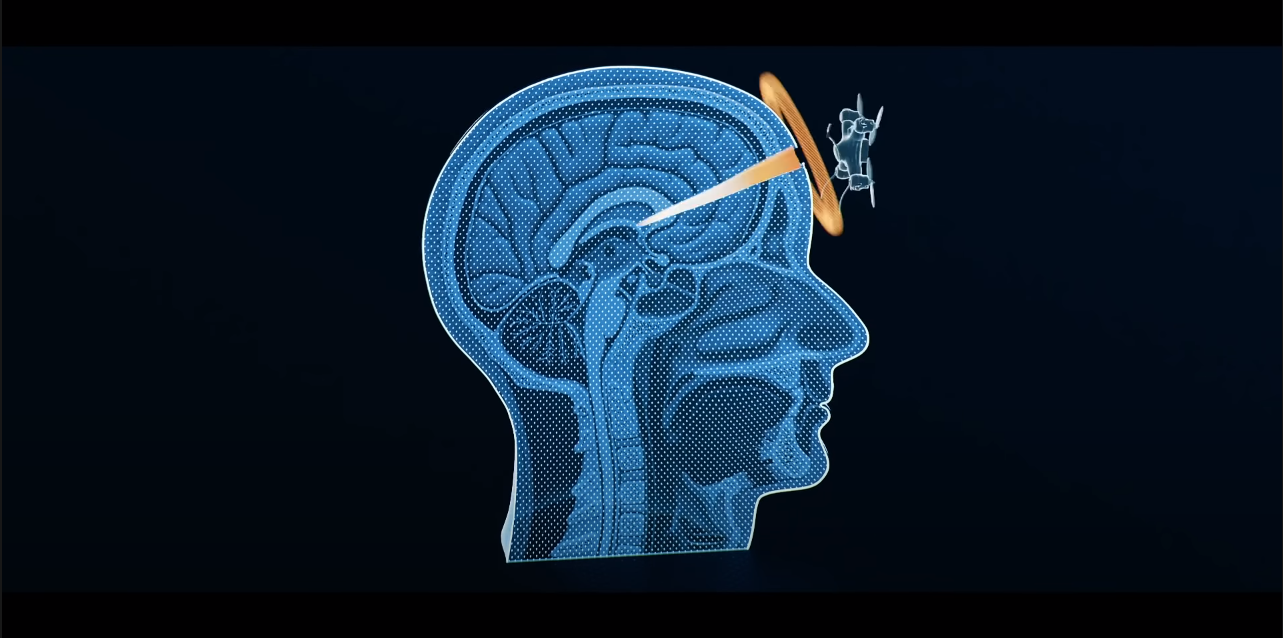










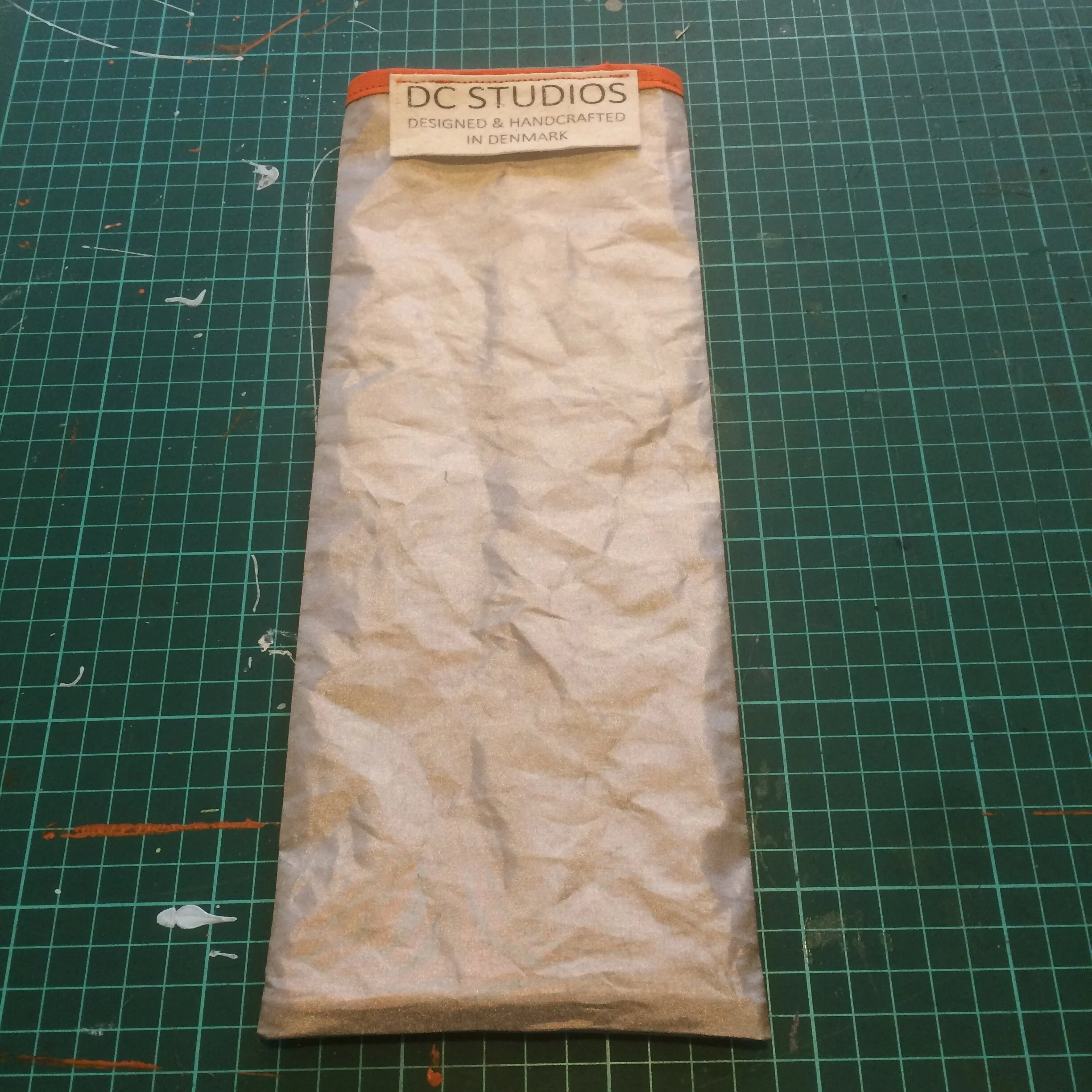









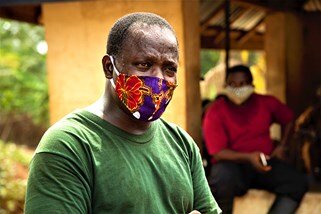





My name is Dylan Cawthorne, and I am an aerospace and drone engineer, applied ethicist, artist, activist, and former Associate Professor at the Drone Center at the University of Southern Denmark in Odense. Now, I am a consultant through my company Dylan Cawthorne Consulting (Danish CVR Number 45718344). My goal is to make the world a better place using ethics, technology, activism, and art. I see myself as a champion for the use of ethics and human values in engineering, and as an activist engineer. My academic area of expertise is using value sensitive design methods and ethical principles to design and build prototype drones - as documented in my PhD thesis and my new book The Ethics of Drone Design. These drones are used in humanitarian and public healthcare contexts in Denmark, Africa, and beyond. I am interested in utilizing art, craft, and creativity to enhance engineering - and engineering to inform art. A common theme in my work is de-centralized technologies and democratic, grassroots organizations and methods. I won the Inspiration Prize from the University of Southern Denmark for my work with the United Nations Sustainable Development goals, and a Peace Rose from the pacifist organization “Never More War”. You can read about my background at this link, see an overview of my projects below, find artworks for sale in the shop, and contact me for public speaking or consulting work via dylan [at] dylancawthorne [dot] com.
-Dylan
You can order the book here!
Use discount code ESA32 at check-out to save 20% until 31 December 2023.
If you are are a journalist or scholar and would like to review the book, please contact me: dylan (at) dylancawthorne (dot) com.
I will be on a book tour in September, October, and November 2023 which will include stops in The Netherlands, Switzerland, and Sweden. For more book tour information, please contact me: dylan (at) dylancawthorne (dot) com.
Book Title: “The ethics of drone design: how value sensitive design can create better technologies”
Publisher: Taylor and Francis - book series in applied ethics
Overview: This book presents a holistic approach to the design and use of drones. It argues that this powerful technology requires high levels of ethical analysis and responsibility—our moral progress must keep pace with our technological progress. Drone technologies support and diminish the flourishing of certain human values, impact power relations between individuals and groups, and add an additional element to the complex network of humans and objects in modern society. The book begins by introducing four prototype drones designed and built by the author: the healthcare drone, the search and rescue drone, the mapping drone, and the spiritual drone. After presenting the technological aspects of each drone, the author considers their social contexts and ethical aspects. What is the use plan of each drone? Where will it operate? Will it support the flourishing of humans and of nature? Should this drone be built? The next part of the book showcases several methods used to develop the prototype drones from the fields of engineering, ethics, and art: value sensitive design, ethical frameworks, capability caution, and speculative design. These methods reveal a more subtle and nuanced view of drones than the currently polarized characterization of “the good drone” or “the killer drone”. The book concludes with specific recommendations for drone engineers, companies, lawmakers, and citizens.
The Ethics of Drone Design is an essential resource for scholars, advanced students, engineers, and designers interested in the ethics of technology.
Here you can find and download all of my academic research including papers, book chapters, and my PhD thesis. Some video links for public talks I have given are provided as well.
I often give public talks, present research at conferences, and give guest lectures both in Denmark and abroad. Some of the topics I cover include:
Drone design and ethics
Value sensitive design
Technology ethics
A.I. Ethics
Technology art
Book and “zine” writing
Fashion, gender, and equality
Contact me about speaking by sending an email to: dylan (at) dylancawthorne (dot) com
Giving a talk about technology ethics as part of the Technology, Ethics, and Design lecture series at FHNW (University of Applied Arts and Sciences) in Northwestern Switzerland.
WORD Festival 2024 - I gave talks about zines, fashion freedom, and my book “The Ethics of Drone Design”
Presenting research at the International Conference of Unmanned Aerial Systems in Atlanta, Georgia USA
Guest lecture at Fourah Bay College in Freetown, Sierra Leone in West Africa. The talk was about ethics and drone design. Photo by Ove Steen Kristensen
Guest lecture at the University of Copenhagen about value sensitive design, drone mapping, and urban planning. Photo by Ela Pastucha
Beachfront talk at Folkemøde in Bornholm about drone ethics. Photo by David Hansen.
Getting ready to present research at the Robphilosophy conference in Helsinki, Finland about incorporating ethics into a large European Union drone project
Getting ready to present research at the International Conference of Unmanned Aerial Systems in Dubrovnik, Croatia about designing drones for calmness
Arriving in Copenhagen for a guest lecture on drone design and ethics at the Danish Ministry of Defense for a course on the Masters of Military Technology
Visiting my former PhD study hosts at the Technical University of Delft. I gave a talk at the department of Values, Technology, and Innovation about technology ethics in practice - the opportunities, and many of the challenges
Photo op at the IEEE Society on Social Implications of Technology at Tufts University in Massachusetts, USA. I presented research about using value sensitive design to build a healthcare drone
I have built up my studio over many years to be able to work in a wide variety of mediums and materials. The studio consists of:
* Office space for my company - workspace for Dylan Cawthorne Consulting
* Design office - workspace for digital design, printing, building small electronics, etc.
* Wood workshop - space for building from wood. Tools include a bandsaw, disc sander, wood lathe, drill press, circular saw, jigsaw, handheld drills, hand tools, and dust collection system
* Metal workshop - space for creating from metal. Tools include a metal lathe and metal milling machine, handheld bandsaw, vise, grinders, buffing machine, and a broad variety of hand tools
* Welding area - stick and TIG welding in steel, stainless, and aluminum
* Fabrication area - includes a table saw, sand blaster, air compressor, spray paint, concrete casting equipment, and material storage
* Material storage - metal, plywood, plastic sheet, mechanical components, bike parts, solid wood in walnut, cherry, and oak, electronic parts including batteries, DC and AC motors, etc.
Many materials are salvaged from metal scrap or electronic waste sources.
Although much of my work is technological, I tend to use analogue methods, and I prefer not to use a computer for my fabrication work.
I wrote a tiny book called “My Workshops” in homage to my studio. You can find the book in the shop
Non-Firm Unincorporated was a three-month long performance art piece (June - August 2025) which investigated capitalism, organizational structures, and creativity. In Non-Firm, myself and a group of artists occupied a storefront of 400 square meters in the center of Odense, Denmark (Kongensgade 26). We made art, engaged in radical rest, and attempted to work in a non-hierarchical and non-instrumental way. You can learn more about NFU at this link: https://www.nonfirmunincorporated.com/
Drones for Peace is an ongoing project which aims to support the research, development, and use of drones for non-violent purposes. In 2025, I organized the Drones for Peace gathering at the International Drone Show in Denmark. This action resulted in local, national, and international news coverage on the BBC, representing a rejection of the increased militarization of Denmark and the European Union. Some of these articles are below, and the Press Release is here.
Flying poor man's weapon has invaded Danish airspace - Politiken
SDU Researcher Demonstrates Against University’s Own Event - TV2 Fyn
Drones for Peace - Not for War - Odense Sees Red
As my final act of defiance, I resigned my position as Associate Professor at the University of Southern Denmark in protest of the increased militarization and reduction in freedom of research. My photo and social media post announcing my resignation are below.
I have decided to resign from my position at the university, in protest of the reduction in freedom of research and increased militarisation. This was not an easy decision to make, I have worked at SDU for 12 years, was a founding member of the Drone Center eight years ago, and was acclaimed by my leadership during the Green transition. Now times are different, and I refuse to be a part of the academic military industrial complex. I have many fond memories from my time at SDU, and I am grateful for my students and many of my colleagues. I earned my PhD in ethics and drone design, and, ironically, these insights helped me decide to leave. My last day is the 31st of this month. I have started my own company, and will do ethics consulting, art, and activism! So you haven’t heard the last of me yet.
Photo by Dylan Cawthorne
PRESS RELEASE - 11 APRIL, 2024
Drone Engineer Makes Playful Exhibition About Tech, War, and Peace
Associate Professor Dylan Cawthorne (PhD) – a specialist in drone design and ethics – creates a defiant exhibition that raises questions about peace, violence - and technology’s role in these activities
In the exhibition, entitled “They are evil, so it’s ok!”, the artist sets out to utilize the materials and methods of technology to explore questions about their ethical – and, arguably – not so ethical use. Drawing on his lifetime of experience designing, building, testing, and reflecting on flying machines, Dylan Cawthorne aims to subvert, play with, and spark debate within the realm of technologically facilitated violence.
“I feel like something I love - drones - has been taken from me. It has been undermined for purposes I am fundamentally opposed to, tarnished the innocence of my childhood, and violated the virtuous nature of my work. Creating this exhibition has helped me to demystify these violent technologies. It has been cathartic to capture them, shrink them down, and play with them in a safe context. No matter your perspective on the topic, I hope this exhibition helps others see drones and warfare in a slightly different way” says the artist.
The exhibition is interactive, and includes a wide variety of new works. The centerpiece is a collection of six unique “Kamikaze Drone Toys” modeled from real weapons made by countries including the USA, Australia, Iran, Russia, and Ukraine . “Drone Watching TV” is a video installation and homage to Nam June Paik’s 1974 “Buddha Watching TV”. “All-Terrain Wind Augmented Tank” (“A-TWAT)” is a cheeky robotic sculpture, inspired by the artist’s newly invented “WindPunk” aesthetics - with a militaristic twist. “Helena and the Israeli Goldfish Experiment” recalls the (in)famous “Helena” work consisting of goldfish in blenders. Here, the artist invites the audience to destroy a golden kamakazi drone. The exhibition touches all senses, including taste, with “Kamikaze Drink”, a series of consumable artworks. The audience is encouraged to drink the bubbly drink while viewing and interacting with the exhibition.
“They are evil, so its ok!” is hosted by the art gallery Filosoffen, located at Filosofgangen 30B, 5000 Odense C, Danmark. It runs during weeks 14 and 15 in 2024, with opening hours from 11:00-17:00 every day (except Mondays). Entry is free. The exhibition closes with a special performance at 16:00 on Sunday the 14th of April, 2024.
All artworks in the exhibition are for sale, and a share of the profits will be donated to the pacifist organization “Never More War” (Aldrig Mere Krig - https://aldrigmerekrig.dk/). Donations are also accepted via MobilePay number 128443.
More information about the artist is at www.dylancawthorne.com, and he can be contacted at: dylan@dylancawthorne.com.
Images by Dylan Cawthorne (reproducon allowed – higher resoluon available, contact dylan@dylancawthorne.com)
The Space Program is an ongoing performance art piece which blurs the lines between the imaginary and the factual: it is real-time science-fiction.
The Space Program investigates technology, power, narcissism, and masculinity through subversion and fun. One aim of the Space Program is to eclipse the narcissism of tech billionaires such as Elon Musk and Jeff Bezos by crashing my sp3rm into the surface of Mars.
The Program includes a series of rocket sculptures:
SP3RM Rocket
SP3RM Rocket: Tower of Light
SP3RM Rocket (Black)
Recently, SP3RM Rocket: Black was balloon launched from Keterminde Beach (Denmark) to 30,000 meters altitude, carrying its DNA payload higher than ever before. Videos of the launch are here:
Next, The Program aims to place my genetic material into orbit. This will pave the way to crashing the payload into Mars before Musk or Bezos reach the planet.
This solo exhibition was hosted by Gallery Dencker & Schneider in Berlin, Germany. In it, I showcased a range of my robotic artworks, including the first SP3RM Rocket, three models of cyborg cactus, and a new signature work - the human carrying robot “F*ck, K*ll”.
Space Sounds - or Rumlyd in Danish - was a collaboration with musicians playing ambient electronic music. Myself and the Art Squad (Alex and Karsten) made the visuals for the event. My contribution was the sculptural element - the huge illuminated sphere (around 4 meters in diameter). The orb provided a curved surface to project visuals on, and the internal color-changing lights flowed with the music.
There is a strong connection between technology and perversion, as explored in this series of kinetic sculptures:
Jumping Robot (Black)
Jumping Robot (Pink)
Jumping Robot (White)
L1berator
The first Tiny Art Gallery - or “Mikro Kunsthal” in Danish - was created and donated to the Odense Municipality by Dylan Cawthorne, Alexander Sokolovs, & Karsten Nymand in September 2023.
Since then, three more tiny art galleries have been built and installed around Odense. They were supported by the Odense Municipality City Development Fund. The tiny art galleries are non-commercial spaces, curated by Dylan and the artist collective ULYS.
The galleries are an exercise in radical openness. They provide an easy entry into the art world, showcasing a variety of works on a monthly rotation basis.
The galleries are open 24/7 and are easily accessible to the public, making it possible to visit any time - day or night. Their glass walls and exposed nature make them a study in trust between the artists and the public.
The small size of the spaces - each a different shape - require the artists to consider the role of scale in their work.
There are four tiny art galleries:
1. The Concrete Brutalist Gallery - Munke Mose Park
◦ Interior dimensions
◦ Diameter: 23 cm
◦ Height: 43 cm
2 The Minimalist Gallery - Ansgars Anlæg
◦ Interior dimensions
◦ Length: 78 cm
◦ Depth: 20 cm
◦ Height: 18 cm
3 The Geodesic Dome - Skibhus
◦ Interior dimensions
◦ Diameter: 53 cm
◦ Height: 32 cm
4 The OG Tiny Art Gallery - Byens Ø, Odense C, Denmark: https://maps.app.goo.gl/V7gkuH9jXcWcBFaF8
◦ Interior dimensions
◦ Width: 49 cm
◦ Depth: 35 cm
◦ Height: 59 cm
◦ Electrical
◦ 12VDC battery
◦ 40 watt solar panel
◦ 4X LED interior lights
A video walkaround of that gallery is here: https://youtu.be/r-22r-ZjEhA
To exhibit at one of the tiny art galleries, write to: dylan (at) dylancawthorne (dot) com.
***PREVIOUS EXHIBITIONS AT THE FIRST TINY ART GALLERY - BYENS Ø, 5000 0DENSE C***
THURSDAY 7TH OF MARCH 2024, 18:30 - ANNA DRELLA HALL
THURSDAY 11TH OF APRIL 2024, 18:30 - HENRIK NOER
THURSDAY 9TH OF MAY 2024, 18:30 - KARSTEN NYMAND
THURSDAY 13TH OF JUNE 2024, 18:30 - ESKILD ANDRESEN
THURSDAY 22ND OF AUGUST 2024, 18:30 - JUILA&JULIA
THURSDAY 8TH OF FEBRUARY 2024, 18:30 - SUNE LOLL, “Mirror Mirror” (triptych sculptures)
THURSDAY 11TH OF JANUARY 2024, 18:30 - HOLGER HOLGER, “The Eternal Smile” (sculpture)
THURSDAY 7TH OF DECEMBER 2023, 18:00 - SNORRE SKEIDSVOLL, “ART”
FRIDAY 10TH OF NOVEMBER 2023, 17:30 - ALEXANDER SOKOLOVS, “Stimmen aus dem Glashaus”
FRIDAY 6TH OF OCTOBER 2023, 18:00 - KRIS SAHLHOLDT, “What remains?”
The fantastic crew from the Odense Municipality that installed the gallery.
The gallery is made from a popcorn machine that was rescued from the electronic waste bin.
This kinetic sculpture was inspired during a trip back to my home state of Alaska. I was astounded and dismayed at the noise, violence, and destruction by humans on the wilderness. The sculpture is slightly figurative, bringing to mind the prototypical Alaskan merged with his intrusive and objectionable technology. The sculpture gave one performance on the coastline in Denmark. It was left in this idyllic setting, and may still be there at these GPS coordinates: 55.524299, 10.550229.
The sculpture is powered by a small nitro engine that I used on one of my model airplanes when I was a kid. This interest in flying things eventually brought me to my career as an aerospace engineer and eventually to Denmark - far away from Alaska.
Thanks to everyone that attended the performance, and that helped me along the way with this work. It means a lot to me.
This drone is being developed through Engineers Without Borders Denmark to support mapping of Sierra Leone in West Africa along with drone education. The mapping will protect local people whose land rights are not always respected - especially women and the poor. The educational aspects could enhance students’ knowledge of aerodynamics, mechanics, materials, and robotics.
The drone is being designed to be low-cost with the ability to be built locally with available materials. The prototype airframe is built of bamboo sticks covered with clear plastic film on the wings, and fabric on the vertical tail. For now the prototype is being tested using manual remote control with a standard brushless drone motor, electronic speed controller, lithium-polymer batteries, and hobby servos.
But the aim is utilize electronic “waste” and alternative low-cost components in the drone. A flight controller consisting of an older Android smartphone is being developed, and well as a simple motor speed controller made from transistors recovered from unused power supplies. Lithium-ion batteries from old laptops and cordless drills are being tested. And low-cost motors - including brushed DC motors from the same cordless drills - are also being characterized.
By using locally-available materials we hope to empower Sierra Leone’s engineering students to build drones to solve local problems. And since they are locally produced, the dependences on outside suppliers are reduced while ease of repair is increased.
A guide to building the bamboo drone is currently being developed by Peter Schmidt Christensen.
The Danish Development Research Network wrote a nice article about this project: “How to build an inexpensive drone African drone with ethics on board”, and my university has written this post about the project.
The prototype drone build in Denmark
Test flight of a bamboo drone made by engineering students from Fourah Bay College in Freetown, Sierra Leone. The drone is being launched by Alfred Mbayoh, and the photo is by Kenneth Bamba.
Engineering students from Fourah Bay College with their nearly completed bamboo drone
Guest lecture at Fourah Bay College, entitled “Good drones in Sierra Leone”
I developed this drone in parallel with the Danish “HealthDrone” project. In this application the drone is designed to transport blood samples from smaller hospitals to larger hospitals that have more advanced testing equipment. Specifically, this drone will fly from the island of Ærø to the city of Svendborg, a distance of 25 km mostly over the ocean.
The drone has been developed using value sensitive design methods and an ethical framework based on the bioethics principles. The aim is to provide the people on the island more rapid and higher quality healthcare while maintaining privacy, ensuring safety, minimizing noise, hindering misuse, and creating meaningful work for the drone operator.
The Danish engineering publication ING published this article about the project: “Forsker om at designe 'sundhedsdrone': Den skal give folk en positiv opfattelse” (“Researcher on design of 'health drone': It should give people a positive experience”) Note: login required.
I have written a number of research papers about the development of this drone, including my PhD thesis:
“Value Sensitive Design of Unmanned Aerial Systems”
“From HealthDrone to FrugalDrone: Value-Sensitive Design of a Blood Sample Transportation Drone”
“Using the Public Perception of Drones to Design for Explicability”
“Capability Caution in UAV Design”
Flight testing of the prototype drone can be seen in these videos.
Fixed wing blood sample cargo drone video playlist
This drone was developed for Danish search and rescue operations in collaboration with two drone masters students. It was designed with the use of an ethical framework which contained nine human values: human-robot interaction/human-human interaction, privacy, human welfare, environmental sustainability, interpretability, safety, quality of work, trust, and accountability. The wooden frame was developed using a method called speculative design, where the designer envisions a preferable future (rather than the most probable future) and designs for that context:
In this preferable future, environmental sustainability, human health, and meaningful work are highly prioritized. The speed of technological ”progress” is slowed to a more controllable pace, and there is emphasis on the use of local resources rather than on the global supply chain. Environmentally unsustainable practices and the use of non-renewable resources such as those based on petroleum are discarded; natural and renewable resources such as trees are grown in vast numbers and utilized locally. Unsafe working conditions are not accepted by the workers themselves, labor unions, and the public at large - both at home and abroad. Technology is developed cautiously and in close collaboration with multiple stakeholders, and care is taken that the new technology does not create unnecessary problems. Engineers, designers, and factory workers enjoy and take pride in their work, and the results of their efforts are utilized locally giving them insight into the impact they have on their community. A large portion of the workforce is in the manufacturing sector which produces the goods needed by the community, and skills and expertise in craft trades are as highly respected as those of knowledge workers.
Prior research has shown that the composite materials used in drone frames create a ten-times increase in cancer during manufacturing compared with wood with carbon fiber and a thermoplastic matrix. Here the approach is taken one step further and the drone’s frame is made completely from renewable and biodegradable wood bonded together with a water-based PVA glue. The structural layout is based on a sandwich panel, with the spar caps made from mahogany hardwood and the core made from end-grain balsawood. The joints are built from quasi-isotropic layups of birch plywood.
Interestingly, there is a long history of wood being used in high-performance aircraft. The development of the wooden frame was documented in the conference paper “Exploring high-performance wooden drone structures through speculative design” written together with Nicolai Iversen.
The drone itself does not operate autonomously as some search and rescue systems, but as a telepresence system which connects a rescuer directly with a victim. Privacy-preserving thermal and visible light cameras are used to help locate the victim. A screen located at the front of the drone shows the rescuer’s face, speakers allow the rescuer to talk with the victim, and a microphone allows the rescuer to hear the victim. This allows human-human interaction rather than human-robot interaction.
Explicability is an important aspect of the design. The drone is non-symmetrical and the camera will be highlighted which makes it easier to discern where the drone is “looking”. Eventually the drone could be clad in high-visibility yellow to show it’s connection with the search and rescue services. The design choices made so far will be utilized as hypotheses and can be tested for their technical as well as social performance.
Search and rescue telepresence drone flight at dusk
“Homage to the Workers of Lucas Aerospace”
(Kites) Tissue paper, bamboo, balsa wood, thread, string, cardboard, spray paint
(Box) Plywood, acrylic, paper, spray paint, steel, LED lights, wiring, battery
In 1976, the workers of Lucas Aerospace proposed a radical change of direction to their management - they wanted to pivot the company from making missiles and other technologies of violence, to dialysis machines and other technologies of peace. The company possessed many high tech design and manufacturing techniques, which could now be used for the good of humanity. The company was in financial trouble, and the workers as well as management knew that without a change they would all be unemployed. Ultimately the plan was not accepted by management.
This work pays homage to the workers of Lucas Aerospace: their forward thinking about technologies of peace and the search for meaningful employment. In this work, the innocence of the kite is utilized in an ongoing performance where the audience is asked to fly the fragile kites. In so doing, they take back the skies from the usual - those of economics, surveillance, and violence, and replace this with joy and technologies of peace.
A video of the kite-flying performance.
Sunna flying her “kite for peace”.
Karsten with his yellow kite.
Me with my pink kite.
The “kite kiosk” on display. Members of the public were invited to borrow a kite, and continue the performance of filling the skies with symbols of peace. The kiosk was installed for two months at Stig ø in Odense, Denmark.
The kite kiosk was later upgraded to include a solar panel and a larger battery to keep the light on inside the box longer. The box became faded, and the kites were in a rough state - both the kites and peace require nurturing and maintenance.
The kite box at night, glowing in the darkness.
This art exhibit, entitled “What Comes After?”, had the theme of “art therapy”. It took place at The Blue Quarter exhibition space in Odense, Denmark in May of 2023.
My contribution was a sculpture and performance called “Emotional Baggage - Pink”. The sculpture consists of an oversized wooden box on wheels which is filled with brightly-colored pink weapons.
In the performance, my character wore their best Mad Max gear. They utilized the weapons in the box to destroy art that represented negative memories and emotions. They utilized spray paint as a flame thrower, a chainsaw, and a megaphone to char, rip, and belittle these artworks. In this way, the performer served as executioner of the bad thoughts these artworks represented.
Emotional Baggage (Pink)
Sculpture & Performance
By Dylan Cawthorne
Wood, spray paint, chainsaw, megaphone, face shield
120X80X0 cm
Therapeutic angle:
Sometimes, you just need to break something.
This exhibition expanded upon the concept of non-human technologies we began in 2021.
The main artwork is called “Have we met before?” and was made by myself, Alexander Sokolovs, Karsten Nymand, and Morten Tryk. Materials include a living Monkey Puzzle tree, steel and aluminum tubing, electronics, and spray paint.
The tree/robot cyborg is around 4 meters tall, weighs a few hundred kilograms, and runs on 24 volt DC electric power.
An article about the exhibition appeared in the regional newspaper.
Videos and proposal by Dylan Cawthorne, posters by Alex Sokolovs.
The cyborg mini cactus, together with an earlier prototype, and with the cyborg tree in the background.
The mini cyborg cactus prior to its performance with red lights on.
The mini cyborg cactus with white lights on.
Newspaper article about the cyborg tree - link to the full article is here.
The team behind the artwork at the opening
I organized this small art exhibition to explore technology from a non-human perspective. It included works from drone and robotics engineers making their first artworks, as well as more experienced artists. My contribution to the exhibition was the design and building of a work called “TV for Plants”, which was the idea of collaborator Alexander Sokolovs. The works are explained in more detail below, with photos by myself and Alexander.
By Dylan Cawthorne Alexander Sokolovs
The ‘TV for Plants’ work is an electro-mechanical sculpture that imagines a reality where plants are an important consumer market, and products are developed and sold to suit their desires. It subverts the ‘human-centric’ approach of almost all aspects of technology and consumerism and explores human’s relationship with the natural world.
The sculpture includes TV programming produced by several contributors suited to non-human/plant viewers, and includes various genres including horror and documentary.
The physical machine is based on upcycled electronic waste and second-hand electronics, combined with high-quality materials such as solid aluminum and brass.
Watching TV with plants. Although the mechanism translates images on the TV screen into pulses of light that the plants can understand, the programming is not designed for and will not be interesting for a human audience - such as the horror film for plants below.
Sensors attach to the plant’s leaves and allow it to change the channel on the remote control.
By Alexander Sokolovs
The ‘plant machine’ is an electro-mechanical sculpture that is able to plant a seed and grow a plant from it automatically. Inspiration comes from automatic coffee machines, but instead of coffee little plants are produced. It is a play on the frequent over-technologization in today’s society by being an unnecessarily complex technological middle layer between nature and the user. It suggests making her or his life easier, while in reality it is equally dependent on its environment and time as the plant would be on its own. The irrationally long waiting times, annoying beeping sounds and occasional failures make it uncomfortable to interact with and one would rather do the machine’s job manually.
Additionally, it emphasizes that even though we live in a place and time where nearly anything can be obtained instantly through possibilities like a constant connection to the internet and delivery services of all kinds, certain processes cannot be accelerated – nature needs its time. It shall make us reflect on what processes, resources and time are necessary, to make the products we take for granted, available to us on a daily basis.
The physical machine is based on an old kitchen mixer which was modified to fit the needs of the sculpture. Light and sound effects draw the attention of the audience and give it life. Audience members are welcome to interact with it, following the instructions shown on the machine’s display.
By Karsten Nymand and Ondrej Pokorny
This plant has its own personality, that has been enhanced by machines, turning it into a cyborg-plant. While the cactus has grown its own natural defensive measures, the machine enhances these so you will never know the plant’s true nature. The machines is connected with the plant, in a way that allows it to keep a good distance between us.
Might it be a commentary of our time in world that is connected so much through technology, that we get less interaction between us, or something about the pandemic where extra shielding has become mandatory, or a cry about the increasing cases of social anxiety and loneliness in our society, or why has this plant made this choice?
The plant-machine hybrid, has been crafted by the artist Karsten and the engineer Ondrej, and some more helpers have helped with the conceptualization, soldering, cutting and gluing.
Plant, recycled table, bucket, screws, wires, ultrasound sensors, steppermotor, 3d printed parts, glue, cardboard, crayon, microcontroller.
Sensors surround the base of the plant and allow it to turn around when anyone approaches. Here, the plant has turned it back on the audience.
Homage to Technology is a kinetic sculpture that calls into question our potentially catastrophic obsession with technology. The title references the 1960 artwork Homage to New York by Jean Tinguely, an expansive, complex, noisy, and ultimately self-destructive sculpture. Homage to Technology utilizes the jet engine, electric power, lithium polymer batteries, and wireless communication, along with steel tubing and industrial ball-bearings to tell its story. Initially calm and motionless, a few synthetic beeps and the system slowly spins to life. The high-pitched engine whines, and the arms begin to rotate, slowly picking up speed. It spins in a circle, consuming electricity, generating noise, but making no forward progress. And as it gains speed, the work tells a story of increasing violence and impending disaster - a system out of control.
The sculpture was a part of the Georgia Tech workshop on Robotics X Art.
Specifications
Width = 2.5 meters
Depth = 1.0 meter
Height = 1.5 meters
Weight = 30 kg
Motor maximum power = 2,400 watts (2.4 kW or 3.2 hp)
DC Voltage = 24 volts
Maximum DC Current = 100 amps
Motor maximum rotational speed = 30,000 RPM
Setting up the sculpture for its only performance. Image credit: Alexander Sokolovs.
I have found art to be a great way to explore, critique, and even subvert drones and other technologies. Often my academic work focuses on designing “good” drones, but it can be useful to think about what makes a drone good by investigating alternative conceptions of the technology. Art gives me the freedom to explore non-typical values in a safe space, and the process of making art and the debate that the pieces initiate are extremely valuable. I also enjoy the craftwork and applying maker and engineering skills to another medium. My works often have the aesthetic of objects that could be functional, which adds a sense of realism and hopefully relatability.
“Electromechanical Sage Bird” is a kinetic sculpture that aims to subverted the “high-tech-ness” of drones while supporting the values of spirituality and environmental sustainability. The sculpture is constructed using “primitive” materials and techniques, including rough pieces of wood lashed together with hemp fibers, and quail feathers as propellers. The payload, rather than a data-collecting camera or a commercially-operated package delivery, is spiritual - a bundle of smoldering sage used for cleansing. A tether connects the drone with the human operator on the ground as an alternative to the anonymous, possibly autonomous drones currently being pursued. The work serves as a critique to contemporary flying robots, and points to alternative ways of envisioning the future of drone technology.
Here is a video of the work. The sculpture was part of the Georgia Tech Workshop on Robotics X Art.
“Electromechanical Sage Bird”; wood, clay, flax fiber, feathers, electric motors and wire
The artist with the work
This research was developed in collaboration with Aimee van Wynsberghe at the Technical University of Delft department of Values, Technology, and Innovation.
The paper has been published open source: "An Ethical Framework for the Design, Development, Implementation, and Assessment of Drones Used in Public Healthcare"
The framework has been applied in this research paper: “"From HealthDrone to FrugalDrone: Value-Sensitive Design of a Blood Sample Transportation Drone"”
And it has been used to build the Danish healthcare drone.
Drones enable some pretty amazing capabilities, but with these capabilities come the risk of misuse as shown in this fictional film. I wrote a research paper on this topic, and provide some guidelines on how drones can be designed to manage these risks:
"Capability caution in drone design"
(Image: Netflix)
I performed some conceptual research on the case of a healthcare cargo drone operated in Peru by the humanitarian organization WeRobotics. In one research paper, I analyzed the existing drone, and proposed a new drone design that better supported the values of human welfare (physical, psychological, and material welfare), and environmental sustainability:
"Value Sensitive Design of a Humanitarian Cargo Drone"
I also contributed to an ethics research paper about how the capability approach from welfare economics may be used to improve the value sensitive design method used in the previous paper:
These drones were built to explore the possibilities of 3D printing a micro fixed-wing drone in only two parts. Two prototypes were built, each with a different wing structure - one solid, and one built-up and covered with plastic film. It turns out that such a design is possible, although the flying characteristics of the small and fast flying-wing still need refinement.
A short news article about the project can be found under the title “First drone out of the SDU composites lab”, and a video of test flying can be found here. My colleague wrote about the drone in the German publication “Quality Engineering”.
3D Printed micro drone flight testing
This drone was developed to protect crops such as cherries from Starlings - by scaring them away - and providing the farmers with an alternative to shooting them.
Early flight test/crash of the hawk micro drone
The Little Smart Things Nimbo was a high-end consumer or professional-grade muiltirotor drone in the 1.5 kg weight class. It could carry a stabilized GoPro Hero Camera and film upward, forward, and downward. It had six rotors for redundancy (it could still fly and be controlled with only five motors). Safety was a high design priority, so aerodynamic 'bumpers' were incorporated around the rotors.
I was the sole mechanical and aerodynamics engineer on this project. I built several prototypes of the drone, and developed it to the point of pre-production.
Little Smart Things has since been purchased by the Danish drone company Sky-Watch.
CAD Rendering of the production model
Pre-production prototype with lightweight, vacuum formed polycarbonate body and bumpers
Early prototype built out of molded carbon fiber
The drone airbag was developed as part of my master thesis “Development of a multirotor drone airbag”. Airbags provide very rapid inflation and thereby can increase safety - especially when drones are in very close proximity to people or obstacles and where using a parachute is not practical. I demonstrated the prototype for the Minister of Higher Education and Science in this video. A playlist of videos showing the development and testing of the drone airbag prototype can be found here.
The Stratolaunch aircraft is the largest in the world, with a wingspan of 117 meters (385 ft) and weight of 540,000 kg (1.2 million lbs). It is a high-altitude launch pad for orbital rockets, which it carries between the main fuselage booms. The aircraft is built of composite materials, and uses six engines from two Boeing 747's.
My role in the project was the feasibility analysis and preliminary design of manufacturing the aircraft, including producing a 2,000 kg prototype wing section.
Here is a video of the Stratolaunch’s first flight
(Cover image: Scaled Composites)
The Boeing 777F is a cargo aircraft developed from the 777 passenger aircraft, but with a completely new internal structure and manufacturing approach.
My role in this project was to help develop the determinate assembly manufacturing method for the fuselage, and perform tolerance analysis and simulations.
(Image: Andrew W. Sieber)
A key premise in the classic paper “Do artifacts have politics?” is that distributed energy systems support democratic values. Renters do not usually have the option to utilize solar energy, but a modular, hybrid on/off-grid system would allow them to generate and manage their own power. I wanted to put this premise into action, and began by creating a small 80 watt system using second-hand equipment for my apartment to explore the idea - a video about this off-grid system is here.
Next, I built a 400-watt system, again using many second-hand components. It was installed without making any modifications to the building, an important consideration for a renter. I gave a talk about the system - both the political implications as well as the costs and environmental impacts - as part of a Repair Café event which can be seen here. I have used the system since 2020, and in the summer it can produce most of the electricity I need. I have noticed an interesting psychological aspect of producing “my own” electricity: I tend to treat it with more respect and use it more sparingly. And when I get home from work it’s exciting to see how much energy has gone into the batteries during the day.
My university wrote this article “Dylan Cawthorne: From Alaska to Odense, from living totally off-grid to very much on-grid to finding a middle way” about the system and my experiences living with various levels of access to electricity.
I helped setup a solar power system for Repair Cafe using second-hand solar panels as well, so that repairs can be conducted with minimal environmental impact.
This series of objects, or “non-objects” – those which appear to be functional, but are not – were created to provide a critical yet playful mockery of the paradigm of “good design”. Contemporary product design is focused on making objects that are intuitive and user friendly. These objects ignore the “rules” of good design, potentially forcing the user into the unfamiliar and frustrating situation of not knowing how the product works or how to interact with it. However, the objects can also be interpreted as a mockery of the state of modern design, and therefore as an “inside joke” with other designers and the audience.
Three non-objects were made in 2021, and were on display at the TESE Gallery in Aarhus, Denmark (the last three in the photos). Since then, another non-object was made in 2022 for a friend’s birthday gift (the first photo).
“Articulated Pythagorean Sphere” - brass, wood, glass, electrical components
“Short-range ether detection meter” - aluminum, stainless steel, wood, electronic components
“Near-invisible electromagnetic spectrum analyzer” - carbon fiber tubes, wood, aluminum, wire
“Portable Unobtanium defect scanner” - aluminum, wood, copper, steel
This was an experiment to understand the capabilities (and limitations) of using low-cost 3D printers to produce custom shoes. The more recently developed flexible filaments showed promise, but were slippery and required the addition of two-component polyurethane rubber (the orange coating) to increase traction. The resulting shoes were lightweight but not rugged enough for outdoors, so I use them as indoor slippers.
In the past it was challenging to spy on someone; it required telephoto lenses, bugs, and lots of waiting. Now, many of us carry around a tracking device in the form of our cell phones. The phone pouch, inspired by this design, blocks all incoming and outgoing signals meaning the phone’s location cannot be tracked. This supports the privacy of the phone’s user - as well as giving them a potentially much-needed break from the onslaught of digital input! To learn more about privacy and technology check out the great book “Ethical IT innovation”.
“THE CRUCIBLE”, 2023
THE CRUCIBLE IS A VESSEL TO REMOVE THE UN-NEEDED, THE UN-NECESSARY, TO GIVE BACK SPACE RATHER THAN OCCUPY MORE SPACE. THE CRUCIBLE IS A PLACE TO BURN THE EXCESS, THE UNNECESSARY, THE CLUTTER.
THE CRUCIBLE IS A FAN LETTER TO NASA, IN CERAMIC FORM. CERAMICS AVE PROTECTED ASTRONAUTS PLUNGING BACK TOWARDS EARTH FOR DECADES. NOW, HERE THEY ARE DOMESTICATED. IN OUR HOMES, SPACE IS PRECIOUS. OUTSIDE OF EARTH, SPACE IS EVERYWHERE.
THE CRUCIBLE PAYS HOMAGE TO MY FAVORITE ARTIST, TOM SACHS – SPECIFICALLY, HIS “SPACE PROGRAM”, AND HIS SERIES OF NASA POTTERY. UNLIKE THE FLAWLESS NASA TECHNOLOGY, THESE HANDMADE OBJECTS ARE PERFECT IN THEIR IMPERFECTIONS.
AS IS THE CRUCIBLE.
AS ARE WE ALL.
GOOD LUCK AND GODSPEED.
Wedding gift for Alain and Oli, 2023
Birthday gift for Jens, 2016
“Questions”, 2016
Upcycling is an important element of many of the things I make. It means taking something that was unused or discarded, and upgrading it into something useful, desirable, and beautiful.
Here is one example, an old fan salvaged from a silo at the local harbor that I transformed into an industrial lamp. The lamp was given to the production company Instafilm for their support in making a promotional film for us at Repair Cafe Odense.
Repair Cafe Odense is a non-profit organization, run by volunteers, that was founded in 2016. We perform and teach repair for free, with the goal of creating a positive environmental, social, and economic impact in our community. Here (and in the thumbnail) is a video that introduces the organization.
I was the foreperson of Repair Cafe Odense from 2018-2020. My focus was on building up a bicycle, electronics, and textile repair workshop at our facility in the Odense Harbor, spreading information about circular economy, and working with politicians to make systemic changes in how 'waste' is handled in Denmark.
I met with the Mayor of Odense to discuss sustainability in this video.
The local newspaper and national organizations have written a few articles about the Repair Cafe:
“Help from Alaska: Dylan spreads sustainability in Odense”
“Less CO2: Repair Café Odense kicks off a promising new year”
You can learn more about Repair Cafe Odense, and find out how to contribute at their website.
Repair Cafe Odense introduction video
Dylan from Repair Cafe Odense talks with Peter Rahbæk Juel, the Mayor of Odense Denmark, about a more sustainable city
I created the “Men in Skirts” art project to explore gender norms and conceptions of masculinity. The project culminated in an interactive exhibition where the audience was invited to put on a skirt - and became part of the artwork. The event raised money for the charity “White Ribbon” which promotes healthy masculinity. More info is available on the webpage: Men in Skirts
I am a volunteer with Engineers Without Borders Denmark (https://iug.dk/en/). Recently I designed a fabric mask to be fabricated by local tailors using locally-available materials to combat the spread of the Corona virus in Africa. My role was to define the shape of the mask, identify the best materials, and produce instructional materials (videos, templates) for the tailors. The project will be the world’s largest clinical trial of fabric face masks, with a sample size of 100,000 people. As of this writing, 45,000 masks have already been produced in Sierra Leone and Guinea-Bissau. This project has also sparked interest in Denmark, and coverage by the national press - see the section “Masks for Denmark”.
Article - “SDU and Engineers without Borders provide face masks in Africa”
Article - “100,000 masks for virus-fighting in Africa: SDU behind the world's largest test of bandages”
(Cover image: Engineers Without Borders DK)
The “masks for Africa” project sparked interest in Denmark as well, and I appeared in the national news demonstrating how to make a fabric face mask at home:
(Image credits: Jens Dresling, Politiken)
In 2019 I visited the operations of the non-profit organization GiveDirectly in Rwanda. I was deeply impressed with their work, and have since become a donor. The concept is simple: they give around $1,000 USD to people in the poorest areas of the country, and the recipients themselves decide the best way to improve their lives. The recipients are empowered and trusted to make their own decisions, and the relatively large amount of money can be life-changing. If you are able, I highly recommend that you donate to GiveDirectly.
I was born and raised off-grid in a cabin on a small island in southeast Alaska, close to Wrangell.
I was fascinated with flight from a young age, and built dozens of remote control airplanes of my own design. I still experience this sense of wonder when something I have helped build flies.
I was a guest on the podcast “Humans of SDU” where we ended up talking a lot about my childhood in Alaska: “Alaska to Odense - Explore Dylan’s Life Journey”.
Here is an article about my background, and what I think about the future and technology: “Hippie son from Alaska researches ethics and technology at SDU: We need to think carefully”
Since leaving Alaska, I was educated as a mechanical engineer (BSME), and worked for 10 years as an aerospace research and development engineer for companies including Boeing, Scaled Composites, and the Danish drone start-up company Little Smart Things. In 2013 I returned to academia to teach and earn a masters degree (MSc) in Product Design and Innovation.
Now, my focus has expanded from the purely technical and I want to address complex problems like climate change, human health and wellbeing, and social justice. I aim to do so by using my skills and knowledge to bridge the conceptual and the physical: using engineering, creativity, and craft fabrication skills to “materialize morality”. I recently completed my PhD (2017-2021) entitled “Value Sensitive Design of Unmanned Aerial Systems” (here are links to a video of my defense presentation, and the thesis). This work is highly interdisciplinary, and involves drawing from a myriad of sources outside engineering including art, philosophy, ethics, and the social sciences. I plan to continue in this research direction, and you can read about my future work at the bottom of the home page.
Hiking near the cabin I grew up in on Etolin Island, Alaska.
One of the many remote control airplanes I designed, built (and crashed) when growing up
An early sculpture.
Me, my sister Dana, and our kitty Paws.
I started working with tools early <3